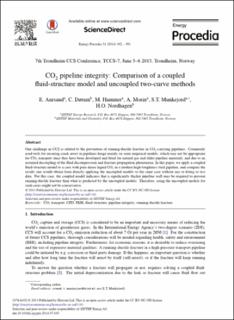| dc.contributor.author | Aursand, Eskil | |
| dc.contributor.author | Dørum, Cato | |
| dc.contributor.author | Hammer, Morten | |
| dc.contributor.author | Morin, Alexandre | |
| dc.contributor.author | Munkejord, Svend Tollak | |
| dc.contributor.author | Nordhagen, Håkon Ottar | |
| dc.date.accessioned | 2020-04-03T12:46:50Z | |
| dc.date.available | 2020-04-03T12:46:50Z | |
| dc.date.created | 2014-08-28T09:38:02Z | |
| dc.date.issued | 2014 | |
| dc.identifier.citation | Energy Procedia. 2014, 51 382-391. | en_US |
| dc.identifier.issn | 1876-6102 | |
| dc.identifier.uri | https://hdl.handle.net/11250/2650353 | |
| dc.description.abstract | One challenge in CCS is related to the prevention of running-ductile fracture in CO2-carrying pipelines. Commonly used tools for ensuring crack arrest in pipelines hinge mainly on semi-empirical models, which may not be appropriate for CO2 transport since they have been developed and fitted for natural gas and older pipeline materials, and due to an assumed decoupling of the fluid decompression and fracture propagation phenomena. In this paper, we apply a coupled fluid-structure model to a case with pure dense liquid CO2 in a modern high-toughness steel pipeline, and compare the results one would obtain from directly applying the uncoupled models to the same case without any re-fitting to test data. For this case, the coupled model indicates that a significantly thicker pipeline wall may be required to prevent running-ductile fracture than what is predicted by the uncoupled models. Therefore, using the uncoupled models for such cases might not be conservative. | en_US |
| dc.language.iso | eng | en_US |
| dc.relation.uri | http://dx.doi.org/10.1016/j.egypro.2014.07.045 | |
| dc.rights | Attribution-NonCommercial-NoDerivatives 4.0 Internasjonal | * |
| dc.rights.uri | http://creativecommons.org/licenses/by-nc-nd/4.0/deed.no | * |
| dc.subject | CO2 transport | en_US |
| dc.subject | CFD | en_US |
| dc.subject | FEM | en_US |
| dc.subject | fluid-structure | en_US |
| dc.subject | pipeline integrity | en_US |
| dc.subject | running-ductile fracture | en_US |
| dc.title | CO2 Pipeline Integrity: Comparison of a Coupled Fluid-structure Model and Uncoupled Two-curve Methods | en_US |
| dc.type | Peer reviewed | en_US |
| dc.type | Journal article | en_US |
| dc.description.version | publishedVersion | en_US |
| dc.source.pagenumber | 382-391 | en_US |
| dc.source.volume | 51 | en_US |
| dc.source.journal | Energy Procedia | en_US |
| dc.identifier.doi | 10.1016/j.egypro.2014.07.045 | |
| dc.identifier.cristin | 1149957 | |
| dc.relation.project | SINTEF Energi AS: 502000339 | en_US |
| dc.relation.project | Norges forskningsråd: 193816 | en_US |
| cristin.unitcode | 7548,60,0,0 | |
| cristin.unitcode | 7401,80,0,0 | |
| cristin.unitcode | 7401,80,6,6 | |
| cristin.unitname | Gassteknologi | |
| cristin.unitname | SINTEF Materialer og kjemi | |
| cristin.unitname | Material- og konstruksjonsmekanikk | |
| cristin.ispublished | true | |
| cristin.fulltext | original | |
| cristin.qualitycode | 1 | |

